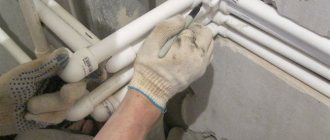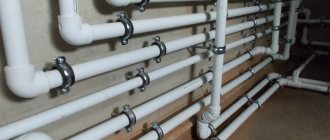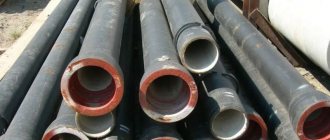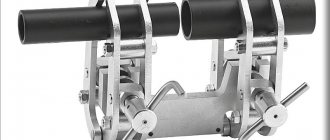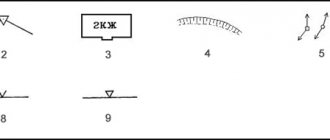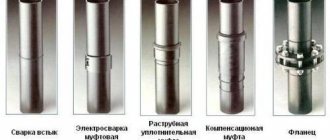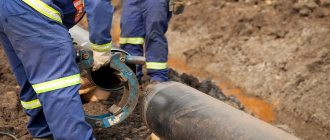Menu:
- Steel pipes: types of joints
- About threaded joining of steel risers
- Connection methods
- How and what to seal pipe joints with
- Types of seals, sealing methods
- Materials for sealing joints
- Threaded pipe connections: pros and cons
- General thread requirements
- Malleable cast iron and connecting parts made from it
- Video
All pipelines are installed according to the pipeline system designs. When laying metal pipes for heating, gas and water supply (cold and hot water), it is necessary to connect the fittings and risers.
The quality of functioning of the gas pipeline, water supply system, and heating system, which is designed to use steam under pressure or hot water with temperatures up to 95 - 100⁰C, depends on the reliability of the articulation of the elements of the pipeline.
The optimal temperature range according to GOST heating systems is up to +60⁰С, depending on operational, climatic and other factors.
Steel pipes: types of joints
Steel pipe connections can be permanent or collapsible, depending on:
- materials from which the risers are made. In addition to metal pipes, cast iron, glass, polymer, and copper products are used;
- properties of transported media;
- operating conditions.
Most often used:
- coupling (threaded, welded, bayonet, sleeve);
- flanged;
- threaded
Disconnect joints. Let's focus on the last option.
In what cases is it used?
When assembling pipelines for various purposes, threaded connections are often used. To make a joint, it is necessary to have a thread on the outer surface of the pipe end and an internal thread on the part being joined.
This type of docking is used to perform the following work:
- connection of two pipes; to make this joint, a connecting coupling is installed, which has internal threads on both sides;
- joining two elements of different diameters, this will require a special adapter coupling;
- turning the pipeline, in this case a fitting in the form of an angle is used;
- branching the pipeline; a tee or cross is used to connect an additional branch;
- creating a dead-end branch; if necessary, installing a plug on the pipe;
- connection of various devices using a threaded adapter fitting.
About threaded joining of steel risers
The threaded connection method is typical for working with steel pipes. To apply threads, use a lathe or die. Cylindrical rolling threads are applied to thin-walled risers.
If the installation rules are followed when laying steel pipes, then twisting in this way will ensure high-quality functioning of the pipeline for many years.
Screwing using threads can be carried out either by directly connecting pipes to each other, or using tees, couplings, shut-off valves, and additional devices.
Which seal is best to choose for installing a heating system?
Today, the main criteria for choosing the best technology for sealing threads in heating system connections are experience and materials to work with.
So, when working with cast iron radiators and shut-off valves, the best option for them is to use flax strands with plumbing paste or silicone heat-resistant sealant.
For small diameter connections up to 25 mm from branded fittings, it is recommended to use FUM tape or adhesive sealant.
To install taps or connect steel, aluminum or bimetallic radiators, you can use the entire arsenal of methods for sealing connections. The only point that you need to pay attention to is that when installing copper pipelines, you must carefully study the instructions for the sealant to avoid incompatibility of the adhesive composition and the color metal
Connection methods
Threaded and non-threaded connections can be of a collapsible or non-separable type. Many are confident that any structure with threads can be disassembled.
If one end of the risers is welded to a fixed surface, then such a pipe device cannot be disconnected. This option is a typical example of a permanent threaded connection.
But such cases are rare. The main number of twists using threads is of the detachable type.
The risers are connected to each other using:
- sweeps;
- bidirectional thread.
Squeegees are used to twist pipes that are motionless relative to their own axes.
Required condition
: one riser must have a long thread cut, and the second a short one.
To connect in this way, first screw the locknut with the coupling onto the long thread. After this, you need to drive the coupling onto a section of the pipe with a short thread, and then tighten it with a lock nut.
The technique of using bidirectional threads is that only a coupling is used to join pipes. It must be screwed onto both risers simultaneously.
Important! When using bidirectional threads, the pipes being connected must be threaded in different directions. Only in this case will the coupling tighten the pipes, and the twisting will be high-quality, reliable, and durable.
What should you consider during the warm-up and assembly process?
As mentioned above, the optimal temperature for connecting individual parts is 260 degrees
Less heating does not provide sufficient efficiency, but you should not overheat, as this will lead to destruction of the structure of the material. Installation of fittings must be carried out with maximum efficiency, and we must not forget about monitoring the evenness and quality of the seam. Movement of the connected parts within a few minutes after processing is unacceptable; it is extremely important to ensure reliable fixation of the structure. If pipes are used in the context of a heating system, then the frequent use of plastic fixing parts will be quite justified.
How and what to seal pipe joints with
Types of seals, sealing methods
To prevent leakage of the pipeline working fluid, it is necessary to properly seal the pipe twists.
When threading steel pipes, the following are used as seals:
- gasket This method of sealing a threaded connection requires relatively thick end pipe cuts. The presence of smooth pipe ends can never ensure tightness. When using a rubber or plastic gasket, this problem is successfully solved. This option is ideal in case of articulation using a union nut;
- winding The materials can be linen strands, polymer threads, FUM tapes in combination with hardening sealants, paints, pastes.
When installing plastic risers, a sealing method is used based on the deformation properties of the material. The essence of this method is that a plastic pipe with an external thread is screwed into a riser with an internal thread. During deformation, plastic contributes to excellent filling of the intermediate space, eliminating the appearance of gaps.
When it comes to pipeline structures with high pressure, cylindrical threaded pipe connections are not entirely appropriate here. In such cases, a conical type connection is used. The principle of connection is that when screwing in, the pipes are tightly pressed until the gap completely disappears.
Materials for sealing joints
To make the joint impenetrable, the following are used as seals:
- flax (tow);
- asbestos;
- FUM tape;
- natural drying oil;
- whitewash;
- minium;
- graphite lubricant, etc.
A reliable sealant when twisting steel pipes onto threads is strands of flax impregnated with red lead or white lead. This connection is easy to install and reliable in terms of sealing. The seal has been used for a very long time and does not lose its popularity today, despite the emergence of artificial analogues.
For those who have little experience in installing fittings and pipes, we suggest that under no circumstances use flax without paint.
At first, the joint will not allow moisture to pass through. But several months will pass, the flax fibers will get wet and begin to decompose. Therefore, the quality of all connections will deteriorate, and in another month or two, water will leak at the junction.
Important! The fibers must be thoroughly impregnated with red lead or whitewash so that not a single dry strand remains.
When operating pipelines with a working environment temperature higher than the boiling point of water, the best sealant option is asbestos thread together with flax strands. To do this, they are impregnated with a mixture of graphite and natural drying oil.
Important! You need to coat the joint with the strands first with red lead, and then with whitewash, and not vice versa.
Before use, the strands are combed out so that the fibers can be separated well.
Important! The strands must be wound “behind the thread” and then soaked with paint. If you lay the tow against the cutting direction, then when screwing on the coupling it will all come out to the sides and you will have to start all over again.
Important! To avoid clogging of the risers, you need to ensure that the tow does not hang from the end or get inside the riser.
Many people use FUM tape, which is in no way inferior to old traditional materials - tow with paint.
Sometimes there is no tightness at the junction of the risers. To eliminate this defect, you need to replace the sealing material, and clean the threaded area from dirt and sealant residues. After this, rewind the linen thread, FUM tape or other sealant, and assemble the structure.
Pastes and sealants of chemical origin are used as additional sealants, which will help strengthen this section of the pipeline.
Application of FUM
FUM tapes and threads are used for sealing threaded connections of hot water supply (DHW), heating systems (CO) and cold water supply (CW). They are also used when connecting gas appliances to the gas pipeline.
Fluoroplastic is a plastic and strong material with a melting point above 400 degrees, resistant to oxygen and aggressive liquids. The thread and tape fill the unevenness of the thread and ensure sealing of the joint. FUM sealing tapes are produced with a width of 10-16 mm and a thickness of 0.08-0.12 mm, FUM threads with a diameter of 0.4-1.5 mm. With temperature changes and vibration, the FUMs are deformed and the threaded connection leaks.
The thickness of the tape winding depends on the diameter of the pipe and the thickness of the tape. For pipes with a diameter of up to 20 mm, 2-3 layers of tape with a thickness of 0.12 or 1-1.5 layers of thread are wound. For pipes with a diameter of up to 40 mm, 5-6 layers or 2-3 layers of thread are wound. For pipes with a diameter of over 40 mm, 8 or more layers of tape or 5 or more layers of thread are wound. For main pipelines, it is preferable to use tapes with silicone mastics.
If the thread is covered with rust, the winding thickness is doubled. Before winding the tape, the threaded connection is cleaned with an iron brush and blown with compressed air. The tape and thread are wound onto the pipe or fitting thread under tension with a force of 0.5-1 kg clockwise. To seal the threaded connections of gas appliances, they are wound counterclockwise.
Wind with a cone from the edge of the joint. If, after cleaning the rust, holes and damage are noticeable on the threads, use a different sealant. FUM is used to seal undamaged threaded connections.
Do not use FUM to seal heating pipes. Temperature changes will damage the FUM, the connection will leak, and water or steam leakage from the heating system will cause burns.
Is FUM tape used for sealing steam and water heating pipes? No, experienced plumbers seal such joints only with flax (tow) and sealant.
Threaded pipe connections: pros and cons
The option using threads has its advantages and disadvantages.
On the positive side, threaded connections differ:
- versatility, which consists in the fact that they can be used for twisting risers of various diameters;
- ease of installation, since to carry out the articulation procedure you do not need to be a professional or have any special knowledge. It is enough to have basic skills in handling a wrench or pipe wrench, or other simple skills in this industry;
- lack of sets of special tools or devices;
- resistance to loads, reliability in operation;
- ease of dismantling the entire pipe structure (if necessary);
- tightness, which is ensured by the presence of sealing materials and compliance with basic rules for laying pipelines.
Flaws:
- if there is no thread on the parts, it is necessary to apply it, which can cause additional difficulties, since not everyone has the skills to cut it and not everyone has sets of special tools;
- when the joints have to be frequently mounted and dismantled, rapid wear of the threaded section of the line part is possible;
- There are times when it is necessary to lock the threaded part, since the fitting may gradually unscrew itself.
Taking into account all the pros and cons, in some situations the best option is to use a threaded connection of steel pipes, and in others, other types of joints of pipeline structure elements. This means that there is no ideal way to connect steel risers: all methods are good if they ensure reliability and tightness of the pipeline.
Important! When choosing a method for joining pipe structures, take into account what material the pipes are made of, the location of the possible connection of parts, operating conditions of the pipeline, and what properties the joining of elements of the pipeline system should have.
Important! For galvanized pipes, only a threaded connection is suitable, since during welding work the galvanization will be damaged, after which the riser will be easily exposed to corrosion.
Possible mistakes
The open ends of the pipes are closed with plugs during installation, and before joining they are checked for clogging. This prevents debris from getting inside the pipeline, which can cause damage to the plumbing or defective operation.
When soldering joints of plastic pipes, it is important to prevent dirt or water from coming into contact with the welded areas - foreign substances reduce the strength of the joint. Enough space must be left between taps, valves and other fittings so that the wings and swing arms installed on them do not interfere with rotation
Simultaneously with the wiring, it is worth designing the sewerage route in such a way that the corresponding risers do not overlap each other. This will improve the conditions for maintenance and repair of networks
Enough space must be left between taps, valves and other fittings so that the wings and swing arms installed on them do not interfere with rotation. Simultaneously with the wiring, it is worth designing the sewerage route in such a way that the corresponding risers do not overlap each other. This will improve the conditions for maintenance and repair of networks.
General thread requirements
The connections are used at the joints of steel heating pipes, water pipes, and gas risers, where welding can be avoided. On ordinary risers, the thread is cut, but on thin-walled products it is applied by rolling.
Main requirements:
- Correctly, well-cut threads must be clean;
- the thread is considered defective if it is torn or incomplete;
- the length of the thread should not be more than one tenth of the length of the part;
- on couplings, it should be of such a size that when the ends of the pipes are fully screwed in, a gap of up to 0.5 cm remains between them (this is the so-called short threaded connection);
- When twisting “one cylinder onto another cylinder”, they use bends. A bend is a piece of pipe with threads on both ends with a coupling and lock nut screwed onto them.
Important! A high-quality squeegee should have a long thread at one end (22-27 threads), and a short thread at the other (5-7 threads).
The advantage and versatility of this part is that it is used if the risers are fixed and cannot be rotated.
Polyethylene
And here two connection methods are popular.
Welding
How to connect polyethylene water pipes by end welding?
- Adjacent elements are trimmed, centered and pressed against the soldering iron mirror until melted.
- After this, the ends are pressed against each other and held until the polyethylene hardens.
- The burr (the part of the seam protruding beyond the pipe) is cleaned off.
End welding is used when connecting pipes with a wall thickness of 4 mm or more. With a huge diameter, it requires the use of mechanical or hydraulic devices.
Compression fittings
When connecting small pipes, plastic fittings with rubber or polyethylene seals are used.
How to connect plastic pipes for water supply yourself using them?
- A union nut, two ring seals and thrust rings are sequentially driven onto the pipe.
- After this, a fitting is put on its end.
- The seal is shifted so that it fits into the gap between the pipe and the fitting, after which it is pressed with thrust rings and clamped with a nut. The tool is not used, the nut is tightened strictly by hand.
Malleable cast iron and connecting parts made from it
The most common ductile iron parts for connecting steel pipes and other pipeline parts are: A) straight couplings B) reducing couplings C) coupling nuts D) fittings E) locknuts E) plugs.
To completely seal the system with a threaded connection, it is necessary to use sealants, for example, gaskets. In addition to them, for other types of fastening additional parts are used. If it is necessary to connect the elements of the pipeline using flanges, that is, without a coupling, then in addition to gaskets, bolts are also needed.
When connecting risers at an angle, they use connecting parts made of ductile cast iron: straight and transition angles, tees, crosses.
Important! The connection will be of high quality and function flawlessly for a long time if, when installing parts, you use parts with straight ends that will be placed at right angles to the connecting parts.
You should pay attention to the threads on the parts, which should be free of burrs and clean.
A cast iron coupling has a low collar around the entire perimeter of the end circumference, which serves to increase the strength of the part, unlike its steel counterpart, which does not have such an element.
The quality of connections depends not so much on the sealing methods and materials, but on the craftsman and the quality of his work. If he is responsible, neat, has basic plumbing knowledge and skills in working with a wrench or pipe wrench, then you won’t find a better specialist. If you follow the basic rules for installing pipeline systems, the pipeline will function for many years. This can be confirmed by anyone who has at least once installed a pipeline system, even the shortest and simplest one.
Try it yourself, experiment and see that you are the best specialist in installing pipeline systems using the threaded method of connecting pipeline elements.
Using couplings
An ordinary coupling for plastic pipelines is a fairly simple part in its design. It consists of:
- cast iron body;
- two nuts;
- rubber gaskets;
- four metal washers.
The coupling can be found at the nearest plumbing store, or, if you have certain skills and knowledge, you can make it yourself. In this case, the characteristics of the coupling must strictly correspond to the dimensions of the products being connected. Ordinary couplings are suitable for both pressure plastic pipelines and pipelines without pressure. With their help, they provide a reliable connection of polypropylene without the use of a soldering iron.
To form a connection, the ends of the pipes must be inserted into the coupling so that they touch in the middle. The ends must pass through washers, gaskets and nuts. Then you need to tighten the nuts tightly so that the pressure on the gaskets is strong enough.
Joining plastic pipes with a coupling provides a 100% sealed seam, even without the use of soldering. But in certain cases, for example, if the pipe is short or adjacent directly to the floor (or other horizontal surface), it is not possible to install an ordinary coupling.
For such difficult cases, a clamping coupling was invented. How to use it? First you need to clean the edge of the plastic pipe. Then you need to unscrew the coupling and put all the fastening parts on the plastic product in the correct sequence. Moreover, the sealing ring should ultimately be located at a distance of at least one centimeter from the edge of the product.
Then you need to insert the body of the clamping coupling into the end of the plastic pipe. And then you need to move all the existing rings to this body and tighten the bolt. And to the thread located on the other side of the coupling, it will be necessary to attach an “American” fitting with a plastic pipe connected to it.
To control the strength of the connection, you must carefully pull the coupling towards you, holding the pipe to which it is attached with your free hand. The coupling must remain stationary. If it moves, it means that the wrong size part was selected.
That is why it adheres so poorly to the pipeline. However, this is easy to fix - you just need to tighten the thread tighter
If it moves, it means that the wrong size part was selected. That is why it adheres so poorly to the pipeline. However, this is easy to fix - you just need to tighten the threads.
Anaerobic sealants: all according to the standard
A new product on the plumbing market, it allows you to assemble or repair plumbing without tools. The appearance of sealants caused a lot of controversy about the reliability of the connection; practice has proven their suitability for work. The advantages of anaerobic sealants can be considered:
- ease of application;
- fixation by hand without tightening with a key;
- speed of installation;
The advantage is the ability to assemble a reliable structure in a hard-to-reach place. When working, you can do without a complex tool, such as a radiator wrench.
This method also has disadvantages:
- can only be applied to new and clean threads; it is advisable to degrease them first;
- impossibility of use on plastic pipes;
- high price.
If necessary, disassembly of threaded pipe connections created with sealant is possible only after they have been heated.
Technologies for working with sealant will not be difficult even for a non-specialist. Apply the gel to the thread, tighten, and leave to harden. The product can be used after the time indicated on the package, this is 40 minutes to 3 hours. After drying, the gel is harmless to humans; it can be used to seal the milk pipe and other communications.
WATCH THE VIDEO
